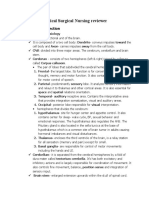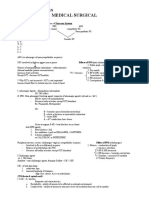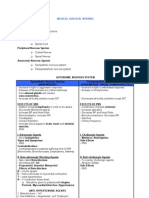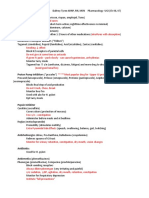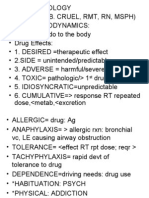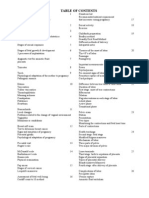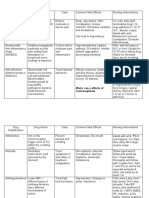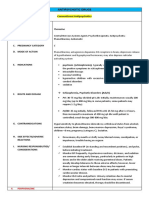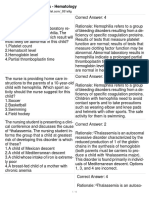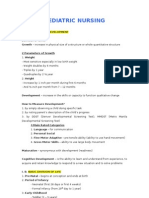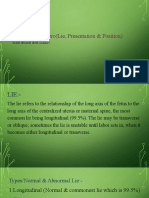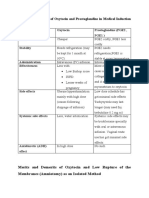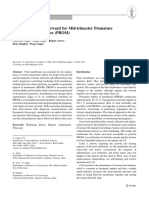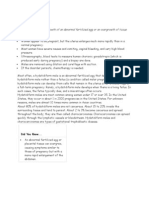Mark Fredderick R. Abejo RN, MAN: Maternal and Child Nursing Bullets
Mark Fredderick R. Abejo RN, MAN: Maternal and Child Nursing Bullets
Uploaded by
Mark DaenosCopyright:
Available Formats
Mark Fredderick R. Abejo RN, MAN: Maternal and Child Nursing Bullets
Mark Fredderick R. Abejo RN, MAN: Maternal and Child Nursing Bullets
Uploaded by
Mark DaenosOriginal Description:
Original Title
Copyright
Available Formats
Share this document
Did you find this document useful?
Is this content inappropriate?
Copyright:
Available Formats
Mark Fredderick R. Abejo RN, MAN: Maternal and Child Nursing Bullets
Mark Fredderick R. Abejo RN, MAN: Maternal and Child Nursing Bullets
Uploaded by
Mark DaenosCopyright:
Available Formats
MATERNAL AND CHILD NURSING BULLETS Mark Fredderick R.
Abejo RN, MAN
Unlike false labor, true labor produces regular rhythmic contractions, abdominal discomfort, progressive descent of the fetus, bloody show, and progressive effacement and dilation of the cervix. To help a mother break the suction of her breast-feeding infant, the nurse should teach her to insert a finger at the corner of the infants mouth. Administering high levels of oxygen to a premature neonate can cause blindness as a result of retrolental fibroplasia. Amniotomy is artificial rupture of the amniotic membranes. During pregnancy, weight gain averages 25 to 30 lb (11 to 13.5 kg). Rubella has a teratogenic effect on the fetus during the first trimester. It produces abnormalities in up to 40% of cases without interrupting the pregnancy. Immunity to rubella can be measured by a hemagglutination inhibition test (rubella titer). This test identifies exposure to rubella Infection and determines susceptibility in pregnant women. In a woman, a titer greater than 1:8 indicates immunity. When used to describe the degree of fetal descent during labor, floating means the presenting part isnt engaged in the pelvic inlet, but is freely movable (ballotable) above the pelvic inlet. When used to describe the degree of fetal descent, engagement means when the largest diameter of the presenting part has passed through the pelvic inlet. Fetal station indicates the location of the presenting part in relation to the ischial spine. Its described as 1, 2, 3, 4, or 5 to indicate the number of centimeters above the level of the ischial spine; station 5 is at the pelvic inlet. Fetal station also is described as +1, +2, +3, +4, or +5 to indicate the number of centimeters it is below the level of the ischial spine; station 0 is at the level of the ischial spine. During the first stage of labor, the side-lying position usually provides the greatest degree of comfort, although the patient may assume any comfortable position. During delivery, if the umbilical cord cant be loosened and slipped from around the neonates neck, it should be clamped with two clamps and cut between the clamps. An Apgar score of 7 to 10 indicates no immediate distress, 4 to 6 indicates moderate distress, and 0 to 3 indicates severe distress. To elicit Moros reflex, the nurse holds the neonate in both hands and suddenly, but gently, drops the neonates head backward. Normally, the neonate abducts and extends all extremities bilaterally and symmetrically, forms a C shape with the thumb and forefinger, and first adducts and then flexes the extremities. Pregnancy-induced hypertension (preeclampsia) is an increase in blood pressure of 30/15 mm Hg over baseline or blood pressure of 140/95 mm Hg on two occasions at least 6 hours apart accompanied by edema and albuminuria after 20 weeks gestation. Positive signs of pregnancy include ultrasound evidence, fetal heart tones, and fetal movement felt by the examiner (not usually present until 4 months gestation Goodells sign is softening of the cervix. Quickening, a presumptive sign of pregnancy, occurs between 16 and 19 weeks gestation. Ovulation ceases during pregnancy. Any vaginal bleeding during pregnancy should be considered a complication until proven otherwise. To estimate the date of delivery using Ngeles rule, the nurse counts backward 3 months from the first day of the last menstrual period and then adds 7 days to this date. At 12 weeks gestation, the fundus should be at the top of the symphysis pubis. Cows milk shouldnt be given to infants younger than age 1 because it has a low linoleic acid content and its protein is difficult for infants to digest. If jaundice is suspected in a neonate, the nurse should examine the infant under natural window light. If natural light is unavailable, the nurse should examine the infant under a white light.
MATERNAL AND CHILD NURSING BULLETS Mark Fredderick R. Abejo RN, MAN
The three phases of a uterine contraction are increment, acme, and decrement. The intensity of a labor contraction can be assessed by the indentability of the uterine wall at the contractions peak. Intensity is graded as mild (uterine muscle is somewhat tense), moderate (uterine muscle is moderately tense), or strong (uterine muscle is boardlike). Chloasma, the mask of pregnancy, is pigmentation of a circumscribed area of skin (usually over the bridge of the nose and cheeks) that occurs in some pregnant women. The gynecoid pelvis is most ideal for delivery. Other types include platypelloid (flat), anthropoid (apelike), and android (malelike). Pregnant women should be advised that there is no safe level of alcohol intake. The frequency of uterine contractions, which is measured in minutes, is the time from the beginning of one contraction to the beginning of the next. Vitamin K is administered to neonates to prevent hemorrhagic disorders because a neonates intestine cant synthesize vitamin K. Before internal fetal monitoring can be performed, a pregnant patients cervix must be dilated at least 2 cm, the amniotic membranes must be ruptured, and the fetuss presenting part (scalp or buttocks) must be at station 1 or lower, so that a small electrode can be attached. Fetal alcohol syndrome presents in the first 24 hours after birth and produces lethargy, seizures, poor sucking reflex, abdominal distention, and respiratory difficulty. Variability is any change in the fetal heart rate (FHR) from its normal rate of 120 to 160 beats/minute. Acceleration is increased FHR; deceleration is decreased FHR. In a neonate, the symptoms of heroin withdrawal may begin several hours to 4 days after birth. In a neonate, the symptoms of methadone withdrawal may begin 7 days to several weeks after birth. In a neonate, the cardinal signs of narcotic withdrawal include coarse, flapping tremors; sleepiness; restlessness; prolonged, persistent, high-pitched cry; and irritability. The nurse should count a neonates respirations for 1 full minute. Chlorpromazine (Thorazine) is used to treat neonates who are addicted to narcotics. The nurse should provide a dark, quiet environment for a neonate who is experiencing narcotic withdrawal. In a premature neonate, signs of respiratory distress include nostril flaring, substernal retractions, and inspiratory grunting. Respiratory distress syndrome (hyaline membrane disease) develops in premature infants because their pulmonary alveoli lack surfactant. Whenever an infant is being put down to sleep, the parent or caregiver should position the infant on the back. (Remember back to sleep.) The male sperm contributes an X or a Y chromosome; the female ovum contributes an X chromosome. Fertilization produces a total of 46 chromosomes, including an XY combination (male) or an XX combination (female). The percentage of water in a neonates body is about 78% to 80%. To perform nasotracheal suctioning in an infant, the nurse positions the infant with his neck slightly hyperextended in a sniffing position, with his chin up and his head tilted back slightly. Organogenesis occurs during the first trimester of pregnancy, specifically, days 14 to 56 of gestation. After birth, the neonates umbilical cord is tied 1 (2.5 cm) from the abdominal wall with a cotton cord, plastic clamp, or rubber band. Gravida is the number of pregnancies a woman has had, regardless of outcome. Para is the number of pregnancies that reached viability, regardless of whether the fetus was delivered alive or stillborn. A fetus is considered viable at 20 weeks gestation. An ectopic pregnancy is one that implants abnormally, outside the uterus. The first stage of labor begins with the onset of labor and ends with full cervical dilation at 10 cm.
MATERNAL AND CHILD NURSING BULLETS Mark Fredderick R. Abejo RN, MAN
The second stage of labor begins with full cervical dilation and ends with the neonates birth. The third stage of labor begins after the neonates birth and ends with expulsion of the placenta. In a full-term neonate, skin creases appear over two-thirds of the neonates feet. Preterm neonates have heel creases that cover less than two-thirds of the feet. The fourth stage of labor (postpartum stabilization) lasts up to 4 hours after the placenta is delivered. This time is needed to stabilize the mothers physical and emotional state after the stress of childbirth. At 20 weeks gestation, the fundus is at the level of the umbilicus. At 36 weeks gestation, the fundus is at the lower border of the rib cage. A premature neonate is one born before the end of the 37th week of gestation. Pregnancy-induced hypertension is a leading cause of maternal death in the United States. A habitual aborter is a woman who has had three or more consecutive spontaneous abortions. Threatened abortion occurs when bleeding is present without cervical dilation. A complete abortion occurs when all products of conception are expelled. Hydramnios (polyhydramnios) is excessive amniotic fluid (more than 2,000 ml in the third trimester). Stress, dehydration, and fatigue may reduce a breast-feeding mothers milk supply. During the transition phase of the first stage of labor, the cervix is dilated 8 to 10 cm and contractions usually occur 2 to 3 minutes apart and last for 60 seconds. A nonstress test is considered nonreactive (positive) if fewer than two fetal heart rate accelerations of at least 15 beats/minute occur in 20 minutes. A nonstress test is considered reactive (negative) if two or more fetal heart rate accelerations of 15 beats/minute above baseline occur in 20 minutes. A nonstress test is usually performed to assess fetal well-being in a pregnant patient with a prolonged pregnancy (42 weeks or more), diabetes, a history of poor pregnancy outcomes, or pregnancy-induced hypertension. A pregnant woman should drink at least eight 8-oz glasses (about 2,000 ml) of water daily. When both breasts are used for breast-feeding, the infant usually doesnt empty the second breast. Therefore, the second breast should be used first at the next feeding. A low-birth-weight neonate weighs 2,500 g (5 lb 8 oz) or less at birth. A very-low-birth-weight neonate weighs 1,500 g (3 lb 5 oz) or less at birth. When teaching parents to provide umbilical cord care, the nurse should teach them to clean the umbilical area with a cotton ball saturated with alcohol after every diaper change to prevent Infection and promote drying. Teenage mothers are more likely to have low-birth-weight neonates because they seek prenatal care late in pregnancy (as a result of denial) and are more likely than older mothers to have nutritional deficiencies. Linea nigra, a dark line that extends from the umbilicus to the mons pubis, commonly appears during pregnancy and disappears after pregnancy. Implantation in the uterus occurs 6 to 10 days after ovum fertilization. Placenta previa is abnormally low implantation of the placenta so that it encroaches on or covers the cervical os. In complete (total) placenta previa, the placenta completely covers the cervical os. In partial (incomplete or marginal) placenta previa, the placenta covers only a portion of the cervical os. Abruptio placentae is premature separation of a normally implanted placenta. It may be partial or complete, and usually causes abdominal Pain, vaginal bleeding, and a boardlike abdomen. Cutis marmorata is mottling or purple discoloration of the skin. Its a transient vasomotor response that occurs primarily in the arms and legs of infants who are exposed to cold.
MATERNAL AND CHILD NURSING BULLETS Mark Fredderick R. Abejo RN, MAN
The classic triad of symptoms of preeclampsia are hypertension, edema, and proteinuria. Additional symptoms of severe preeclampsia include hyperreflexia, cerebral and vision disturbances, and epigastric Pain. Ortolanis sign (an audible click or palpable jerk that occurs with thigh abduction) confirms congenital hip dislocation in a neonate. The first immunization for a neonate is the hepatitis B vaccine, which is administered in the nursery shortly after birth. If a patient misses a menstrual period while taking an oral contraceptive exactly as prescribed, she should continue taking the contraceptive. If a patient misses two consecutive menstrual periods while taking an oral contraceptive, she should discontinue the contraceptive and take a pregnancy test. If a patient who is taking an oral contraceptive misses a dose, she should take the pill as soon as she remembers or take two at the next scheduled interval and continue with the normal schedule. If a patient who is taking an oral contraceptive misses two consecutive doses, she should double the dose for 2 days and then resume her normal schedule. She also should use an additional birth control method for 1 week. Eclampsia is the occurrence of seizures that arent caused by a cerebral disorder in a patient who has pregnancy-induced hypertension. In placenta previa, bleeding is painless and seldom fatal on the first occasion, but it becomes heavier with each subsequent episode. Treatment for abruptio placentae is usually immediate cesarean delivery. Drugs used to treat withdrawal symptoms in neonates include phenobarbital (Luminal), camphorated opium tincture (paregoric), and diazepam (Valium). Infants with Down syndrome typically have marked hypotonia, floppiness, slanted eyes, excess skin on the back of the neck, flattened bridge of the nose, flat facial features, spadelike hands, short and broad feet, small male genitalia, absence of Moros reflex, and a simian crease on the hands. The failure rate of a contraceptive is determined by the experience of 100 women for 1 year. Its expressed as pregnancies per 100 woman-years. The narrowest diameter of the pelvic inlet is the anteroposterior (diagonal conjugate). The chorion is the outermost extraembryonic membrane that gives rise to the placenta. The corpus luteum secretes large quantities of progesterone. From the 8th week of gestation through delivery, the developing cells are known as a fetus. In an incomplete abortion, the fetus is expelled, but parts of the placenta and membrane remain in the uterus. The circumference of a neonates head is normally 2 to 3 cm greater than the circumference of the chest. After administering magnesium sulfate to a pregnant patient for hypertension or preterm labor, the nurse should monitor the respiratory rate and deep tendon reflexes. During the first hour after birth (the period of reactivity), the neonate is alert and awake. When a pregnant patient has undiagnosed vaginal bleeding, vaginal examination should be avoided until ultrasonography rules out placenta previa. After delivery, the first Nursing action is to establish the neonates airway. Nursing interventions for a patient with placenta previa include positioning the patient on her left side for maximum fetal perfusion, monitoring fetal heart tones, and administering I.V. fluids and oxygen, as ordered. The specific gravity of a neonates urine is 1.003 to 1.030. A lower specific gravity suggests overhydration; a higher one suggests dehydration. The neonatal period extends from birth to day 28. Its also called the first 4 weeks or first month of life.
MATERNAL AND CHILD NURSING BULLETS Mark Fredderick R. Abejo RN, MAN
A woman who is breast-feeding should rub a mild emollient cream or a few drops of breast milk (or colostrum) on the nipples after each feeding. She should let the breasts air-dry to prevent them from cracking. Breast-feeding mothers should increase their fluid intake to 2 to 3 qt (2,500 to 3,000 ml) daily. After feeding an infant with a cleft lip or palate, the nurse should rinse the infants mouth with sterile water. The nurse instills erythromycin in a neonates eyes primarily to prevent blindness caused by gonorrhea or chlamydia. Human immunodeficiency virus (HIV) has been cultured in breast milk and can be transmitted by an HIVpositive mother who breast-feeds her infant. A fever in the first 24 hours postpartum is most likely caused by dehydration rather than Infection. Preterm neonates or neonates who cant maintain a skin temperature of at least 97.6 F (36.4 C) should receive care in an incubator (Isolette) or a radiant warmer. In a radiant warmer, a heat-sensitive probe taped to the neonates skin activates the heater unit automatically to maintain the desired temperature. During labor, the resting phase between contractions is at least 30 seconds. Lochia rubra is the vaginal discharge of almost pure blood that occurs during the first few days after childbirth. Lochia serosa is the serous vaginal discharge that occurs 4 to 7 days after childbirth. Lochia alba is the vaginal discharge of decreased blood and increased leukocytes thats the final stage of lochia. It occurs 7 to 10 days after childbirth. Colostrum, the precursor of milk, is the first secretion from the breasts after delivery. The length of the uterus increases from 2 (6.3 cm) before pregnancy to 12 (32 cm) at term. To estimate the true conjugate (the smallest inlet measurement of the pelvis), deduct 1.5 cm from the diagonal conjugate (usually 12 cm). A true conjugate of 10.5 cm enables the fetal head (usually 10 cm) to pass. The smallest outlet measurement of the pelvis is the intertuberous diameter, which is the transverse diameter between the ischial tuberosities. Electronic fetal monitoring is used to assess fetal well-being during labor. If compromised fetal status is suspected, fetal blood pH may be evaluated by obtaining a scalp sample. In an emergency delivery, enough pressure should be applied to the emerging fetuss head to guide the descent and prevent a rapid change in pressure within the molded fetal skull. After delivery, a multiparous woman is more susceptible to bleeding than a primiparous woman because her uterine muscles may be overstretched and may not contract efficiently. Neonates who are delivered by cesarean birth have a higher incidence of respiratory distress syndrome. The nurse should suggest ambulation to a postpartum patient who has gas Pain and flatulence. Massaging the uterus helps to stimulate contractions after the placenta is delivered. When providing phototherapy to a neonate, the nurse should cover the neonates eyes and genital area. The narcotic antagonist naloxone (Narcan) may be given to a neonate to correct respiratory depression caused by narcotic administration to the mother during labor. In a neonate, symptoms of respiratory distress syndrome include expiratory grunting or whining, sandpaper breath sounds, and seesaw retractions. Cerebral palsy presents as asymmetrical movement, irritability, and excessive, feeble crying in a long, thin infant. The nurse should assess a breech-birth neonate for hydrocephalus, hematomas, fractures, and other anomalies caused by birth trauma. When a patient is admitted to the unit in active labor, the nurses first action is to listen for fetal heart tones. In a neonate, long, brittle fingernails are a sign of postmaturity. Desquamation (skin peeling) is common in postmature neonates.
MATERNAL AND CHILD NURSING BULLETS Mark Fredderick R. Abejo RN, MAN
A mother should allow her infant to breast-feed until the infant is satisfied. The time may vary from 5 to 20 minutes. Nitrazine paper is used to test the pH of vaginal discharge to determine the presence of amniotic fluid. A pregnant patient normally gains 2 to 5 lb (1 to 2.5 kg) during the first trimester and slightly less than 1 lb (0.5 kg) per week during the last two trimesters. Neonatal jaundice in the first 24 hours after birth is known as pathological jaundice and is a sign of erythroblastosis fetalis. A classic difference between abruptio placentae and placenta previa is the degree of Pain. Abruptio placentae causes Pain, whereas placenta previa causes painless bleeding. Because a major role of the placenta is to function as a fetal lung, any condition that interrupts normal blood flow to or from the placenta increases fetal partial pressure of arterial carbon dioxide and decreases fetal pH. Precipitate labor lasts for approximately 3 hours and ends with delivery of the neonate. Methylergonovine (Methergine) is an oxytocic agent used to prevent and treat postpartum hemorrhage caused by uterine atony or subinvolution. As emergency treatment for excessive uterine bleeding, 0.2 mg of methylergonovine (Methergine) is injected I.V. over 1 minute while the patients blood pressure and uterine contractions are monitored. Braxton Hicks contractions are usually felt in the abdomen and dont cause cervical change. True labor contractions are felt in the front of the abdomen and back and lead to progressive cervical dilation and effacement. The average birth weight of neonates born to mothers who smoke is 6 oz (170 g) less than that of neonates born to nonsmoking mothers. Culdoscopy is visualization of the pelvic organs through the posterior vaginal fornix. The nurse should teach a pregnant vegetarian to obtain protein from alternative sources, such as nuts, soybeans, and legumes. The nurse should instruct a pregnant patient to take only prescribed prenatal vitamins because over-thecounter high-potency vitamins may harm the fetus. High-sodium foods can cause fluid retention, especially in pregnant patients. A pregnant patient can avoid constipation and hemorrhoids by adding fiber to her diet. If a fetus has late decelerations (a sign of fetal hypoxia), the nurse should instruct the mother to lie on her left side and then administer 8 to 10 L of oxygen per minute by mask or cannula. The nurse should notify the physician. The side-lying position removes pressure on the inferior vena cava. Oxytocin (Pitocin) promotes lactation and uterine contractions. Lanugo covers the fetuss body until about 20 weeks gestation. Then it begins to disappear from the face, trunk, arms, and legs, in that order. In a neonate, hypoglycemia causes temperature instability, hypotonia, jitteriness, and seizures. Premature, postmature, small-for-gestational-age, and large-for-gestational-age neonates are susceptible to this disorder. Neonates typically need to consume 50 to 55 cal per pound of body weight daily. Because oxytocin (Pitocin) stimulates powerful uterine contractions during labor, it must be administered under close observation to help prevent maternal and fetal distress. During fetal heart rate monitoring, variable decelerations indicate compression or prolapse of the umbilical cord. Cytomegalovirus is the leading cause of congenital viral Infection. Tocolytic therapy is indicated in premature labor, but contraindicated in fetal death, fetal distress, or severe hemorrhage. Through ultrasonography, the biophysical profile assesses fetal well-being by measuring fetal breathing movements, gross body movements, fetal tone, reactive fetal heart rate (nonstress test), and qualitative amniotic fluid volume.
MATERNAL AND CHILD NURSING BULLETS Mark Fredderick R. Abejo RN, MAN
A neonate whose mother has diabetes should be assessed for hyperinsulinism. In a patient with preeclampsia, epigastric Pain is a late symptom and requires immediate medical intervention. After a stillbirth, the mother should be allowed to hold the neonate to help her come to terms with the death. Molding is the process by which the fetal head changes shape to facilitate movement through the birth canal. If a woman receives a spinal block before delivery, the nurse should monitor the patients blood pressure closely. If a woman suddenly becomes hypotensive during labor, the nurse should increase the infusion rate of I.V. fluids as prescribed. The best technique for assessing jaundice in a neonate is to blanch the tip of the nose or the area just above the umbilicus. During fetal heart monitoring, early deceleration is caused by compression of the head during labor. After the placenta is delivered, the nurse may add oxytocin (Pitocin) to the patients I.V. solution, as prescribed, to promote postpartum involution of the uterus and stimulate lactation. Pica is a craving to eat nonfood items, such as dirt, crayons, chalk, glue, starch, or hair. It may occur during pregnancy and can endanger the fetus. A pregnant patient should take folic acid because this nutrient is required for rapid cell division. A woman who is taking clomiphene (Clomid) to induce ovulation should be informed of the possibility of multiple births with this drug. If needed, cervical suturing is usually done between 14 and 18 weeks gestation to reinforce an incompetent cervix and maintain pregnancy. The suturing is typically removed by 35 weeks gestation. During the first trimester, a pregnant woman should avoid all drugs unless doing so would adversely affect her health. Most drugs that a breast-feeding mother takes appear in breast milk. Respiratory distress syndrome develops in premature neonates because their alveoli lack surfactant. The most common method of inducing labor after artificial rupture of the membranes is oxytocin (Pitocin) infusion. After the amniotic membranes rupture, the initial Nursing action is to assess the fetal heart rate. The most common reasons for cesarean birth are malpresentation, fetal distress, cephalopelvic disproportion, pregnancy-induced hypertension, previous cesarean birth, and inadequate progress in labor. Amniocentesis increases the risk of spontaneous abortion, trauma to the fetus or placenta, premature labor, Infection, and Rh sensitization of the fetus. After amniocentesis, abdominal cramping or spontaneous vaginal bleeding may indicate complications. To prevent her from developing Rh antibodies, an Rh-negative primigravida should receive Rho(D) immune globulin (RhoGAM) after delivering an Rh-positive neonate. 8. If a pregnant patients test results are negative for glucose but positive for acetone, the nurse should assess the patients diet for inadequate caloric intake. If a pregnant patients test results are negative for glucose but positive for acetone, the nurse should assess the patients diet for inadequate caloric intake. Rubella Infection in a pregnant patient, especially during the first trimester, can lead to spontaneous abortion or stillbirth as well as fetal cardiac and other birth defects. A pregnant patient should take an iron supplement to help prevent anemia. Direct antiglobulin (direct Coombs) test is used to detect maternal antibodies attached to red blood cells in the neonate. Nausea and vomiting during the first trimester of pregnancy are caused by rising levels of the hormone human chorionic gonadotropin.
MATERNAL AND CHILD NURSING BULLETS Mark Fredderick R. Abejo RN, MAN
Before discharging a patient who has had an abortion, the nurse should instruct her to report bright red clots, bleeding that lasts longer than 7 days, or signs of Infection, such as a temperature of greater than 100 F (37.8 C), foul-smelling vaginal discharge, severe uterine cramping, nausea, or vomiting. When informed that a patients amniotic membrane has broken, the nurse should check fetal heart tones and then maternal vital signs. The duration of pregnancy averages 280 days, 40 weeks, 9 calendar months, or 10 lunar months. The initial weight loss for a healthy neonate is 5% to 10% of birth weight. The normal hemoglobin value in neonates is 17 to 20 g/dl. Crowning is the appearance of the fetuss head when its largest diameter is encircled by the vulvovaginal ring. A multipara is a woman who has had two or more pregnancies that progressed to viability, regardless of whether the offspring were alive at birth. In a pregnant patient, preeclampsia may progress to eclampsia, which is characterized by seizures and may lead to coma. The Apgar score is used to assess the neonates vital functions. Its obtained at 1 minute and 5 minutes after delivery. The score is based on respiratory effort, heart rate, muscle tone, reflex irritability, and color. Because of the anti-insulin effects of placental hormones, insulin requirements increase during the third trimester. Gestational age can be estimated by ultrasound measurement of maternal abdominal circumference, fetal femur length, and fetal head size. These measurements are most accurate between 12 and 18 weeks gestation. Skeletal system abnormalities and ventricular septal defects are the most common disorders of infants who are born to diabetic women. The incidence of congenital malformation is three times higher in these infants than in those born to nondiabetic women. Skeletal system abnormalities and ventricular septal defects are the most common disorders of infants who are born to diabetic women. The incidence of congenital malformation is three times higher in these infants than in those born to nondiabetic women. The patient with preeclampsia usually has puffiness around the eyes or edema in the hands (for example, I cant put my wedding ring on.). Kegel exercises require contraction and relaxation of the perineal muscles. These exercises help strengthen pelvic muscles and improve urine control in postpartum patients. Symptoms of postpartum depression range from mild postpartum blues to intense, suicidal, depressive psychosis. The preterm neonate may require gavage feedings because of a weak sucking reflex, uncoordinated sucking, or respiratory distress. Acrocyanosis (blueness and coolness of the arms and legs) is normal in neonates because of their immature peripheral circulatory system. To prevent ophthalmia neonatorum (a severe eye Infection caused by maternal gonorrhea), the nurse may administer one of three drugs, as prescribed, in the neonates eyes: tetracycline, silver nitrate, or erythromycin. Neonatal testing for phenylketonuria is mandatory in most states. The nurse should place the neonate in a 30-degree Trendelenburg position to facilitate mucus drainage. The nurse may suction the neonates nose and mouth as needed with a bulb syringe or suction trap. To prevent heat loss, the nurse should place the neonate under a radiant warmer during suctioning and initial delivery-room care, and then wrap the neonate in a warmed blanket for transport to the nursery. The umbilical cord normally has two arteries and one vein. When providing care, the nurse should expose only one part of an infants body at a time. Lightening is settling of the fetal head into the brim of the pelvis.
MATERNAL AND CHILD NURSING BULLETS Mark Fredderick R. Abejo RN, MAN
If the neonate is stable, the mother should be allowed to breast-feed within the neonates first hour of life. The nurse should check the neonates temperature every 1 to 2 hours until its maintained within normal limits. At birth, a neonate normally weighs 5 to 9 lb (2 to 4 kg), measures 18 to 22 (45.5 to 56 cm) in length, has a head circumference of 13 to 14 (34 to 35.5 cm), and has a chest circumference thats 1 (2.5 cm) less than the head circumference. In the neonate, temperature normally ranges from 98 to 99 F (36.7 to 37.2 C), apical pulse rate averages 120 to 160 beats/minute, and respirations are 40 to 60 breaths/minute. The diamond-shaped anterior fontanel usually closes between ages 12 and 18 months. The triangular posterior fontanel usually closes by age 2 months. In the neonate, a straight spine is normal. A tuft of hair over the spine is an abnormal finding. Prostaglandin gel may be applied to the vagina or cervix to ripen an unfavorable cervix before labor induction with oxytocin (Pitocin). Supernumerary nipples are occasionally seen on neonates. They usually appear along a line that runs from each axilla, through the normal nipple area, and to the groin. Meconium is a material that collects in the fetuss intestines and forms the neonates first feces, which are black and tarry. The presence of meconium in the amniotic fluid during labor indicates possible fetal distress and the need to evaluate the neonate for meconium aspiration. To assess a neonates rooting reflex, the nurse touches a finger to the cheek or the corner of the mouth. Normally, the neonate turns his head toward the stimulus, opens his mouth, and searches for the stimulus. Harlequin sign is present when a neonate who is lying on his side appears red on the dependent side and pale on the upper side. Mongolian spots can range from brown to blue. Their color depends on how close melanocytes are to the surface of the skin. They most commonly appear as patches across the sacrum, buttocks, and legs. Mongolian spots are common in non-white infants and usually disappear by age 2 to 3 years. Vernix caseosa is a cheeselike substance that covers and protects the fetuss skin in utero. It may be rubbed into the neonates skin or washed away in one or two baths. Caput succedaneum is edema that develops in and under the fetal scalp during labor and delivery. It resolves spontaneously and presents no danger to the neonate. The edema doesnt cross the suture line. Nevus flammeus, or port-wine stain, is a diffuse pink to dark bluish red lesion on a neonates face or neck. The Guthrie test (a screening test for phenylketonuria) is most reliable if its done between the second and sixth days after birth and is performed after the neonate has ingested protein. To assess coordination of sucking and swallowing, the nurse should observe the neonates first breastfeeding or sterile water bottle-feeding. To establish a milk supply pattern, the mother should breast-feed her infant at least every 4 hours. During the first month, she should breast-feed 8 to 12 times daily (demand feeding). To avoid contact with blood and other body fluids, the nurse should wear gloves when handling the neonate until after the first bath is given. If a breast-fed infant is content, has good skin turgor, an adequate number of wet diapers, and normal weight gain, the mothers milk supply is assumed to be adequate. In the supine position, a pregnant patients enlarged uterus impairs venous return from the lower half of the body to the heart, resulting in supine hypotensive syndrome, or inferior vena cava syndrome. Tocolytic agents used to treat preterm labor include terbutaline (Brethine), ritodrine (Yutopar), and magnesium sulfate. A pregnant woman who has hyperemesis gravidarum may require hospitalization to treat dehydration and starvation. Diaphragmatic hernia is one of the most urgent neonatal surgical emergencies. By compressing and displacing the lungs and heart, this disorder can cause respiratory distress shortly after birth.
MATERNAL AND CHILD NURSING BULLETS Mark Fredderick R. Abejo RN, MAN
Common complications of early pregnancy (up to 20 weeks gestation) include fetal loss and serious threats to maternal health. Fetal embodiment is a maternal developmental task that occurs in the second trimester. During this stage, the mother may complain that she never gets to sleep because the fetus always gives her a thump when she tries. Visualization in pregnancy is a process in which the mother imagines what the child shes carrying is like and becomes acquainted with it. Hemodilution of pregnancy is the increase in blood volume that occurs during pregnancy. The increased volume consists of plasma and causes an imbalance between the ratio of red blood cells to plasma and a resultant decrease in hematocrit. Mean arterial pressure of greater than 100 mm Hg after 20 weeks of pregnancy is considered hypertension. The treatment for supine hypotension syndrome (a condition that sometimes occurs in pregnancy) is to have the patient lie on her left side. A contributing factor in dependent edema in the pregnant patient is the increase of femoral venous pressure from 10 mm Hg (normal) to 18 mm Hg (high). Hyperpigmentation of the pregnant patients face, formerly called chloasma and now referred to as melasma, fades after delivery. The hormone relaxin, which is secreted first by the corpus luteum and later by the placenta, relaxes the connective tissue and cartilage of the symphysis pubis and the sacroiliac joint to facilitate passage of the fetus during delivery. Progesterone maintains the integrity of the pregnancy by inhibiting uterine motility. Ladins sign, an early indication of pregnancy, causes softening of a spot on the anterior portion of the uterus, just above the uterocervical juncture. During pregnancy, the abdominal line from the symphysis pubis to the umbilicus changes from linea alba to linea nigra. In neonates, cold stress affects the circulatory, regulatory, and respiratory systems. Parity doesnt refer to the number of infants delivered, only the number of deliveries.
You might also like
- Peds HESI Study GuideDocument5 pagesPeds HESI Study Guidemscostello985367% (9)
- SurrogacyDocument30 pagesSurrogacyAfidatul AzwaNo ratings yet
- Care of The Patient With COVID-19 COVID Case Study 1Document3 pagesCare of The Patient With COVID-19 COVID Case Study 1Ashley HernandezNo ratings yet
- Pentagon Maternal and Child PDFDocument38 pagesPentagon Maternal and Child PDFmarie89meNo ratings yet
- Gapuz Reviewer PDFDocument144 pagesGapuz Reviewer PDFAngela Gwynette OngjocoNo ratings yet
- Med-Surg Nusing BulletsDocument65 pagesMed-Surg Nusing BulletsHarley C. Tan100% (1)
- Mus Culo SkeletalDocument16 pagesMus Culo Skeletalshenric16100% (2)
- IMCI ChartDocument33 pagesIMCI Chartrazorblades0012No ratings yet
- MCH BulletsDocument13 pagesMCH BulletsPatziedawn GonzalvoNo ratings yet
- Mark Fredderick R. Abejo RN, MAN: Maternal and Child Nursing BulletsDocument9 pagesMark Fredderick R. Abejo RN, MAN: Maternal and Child Nursing BulletsCrystal Ann Monsale TadiamonNo ratings yet
- 350 Nursing Bullets MaternalDocument18 pages350 Nursing Bullets MaternalJulian ParadaNo ratings yet
- Maternity and Newborn Nursing ReviewerDocument40 pagesMaternity and Newborn Nursing Reviewerrahkel08No ratings yet
- Communicablediseases 110227001506 Phpapp02 PDFDocument30 pagesCommunicablediseases 110227001506 Phpapp02 PDFCrystal Ann Monsale TadiamonNo ratings yet
- Medical Surgical Nursing ReviewerDocument8 pagesMedical Surgical Nursing ReviewerDavid Brillo0% (1)
- Medical Surgical NotesDocument18 pagesMedical Surgical NotesshalomNo ratings yet
- Basic Concepts in Pregnancy: Prenatal Care and Health TeachingsDocument12 pagesBasic Concepts in Pregnancy: Prenatal Care and Health Teachingswanda100% (2)
- Compilation of MS NotesDocument81 pagesCompilation of MS Notesdis_is_meNo ratings yet
- Medical Surgical Nursing TionkoDocument40 pagesMedical Surgical Nursing TionkojeshemaNo ratings yet
- Upper GI Disorders Study GuideDocument10 pagesUpper GI Disorders Study Guidemelpietrowski100% (1)
- Pharma Gapuz IntroDocument40 pagesPharma Gapuz IntroHayes CloverNo ratings yet
- Maternal NursingDocument37 pagesMaternal NursingCai Velasco DecenaNo ratings yet
- ACFrOgC7mxGaX9liXL4MXhyIib2My7OJ2fZppJtUXaiwHAXPWv6byWDD3pHlmU1oEOp6KBWon7YU jkOlWtd JuFuLgT1S2gy3uqt5qGGQC - XMeRzHD ILMtafpI6OCKEmRORkbnWIkeZVIfnbmDocument22 pagesACFrOgC7mxGaX9liXL4MXhyIib2My7OJ2fZppJtUXaiwHAXPWv6byWDD3pHlmU1oEOp6KBWon7YU jkOlWtd JuFuLgT1S2gy3uqt5qGGQC - XMeRzHD ILMtafpI6OCKEmRORkbnWIkeZVIfnbmCenitserNo ratings yet
- Fluids and Electrolytes DrillsDocument7 pagesFluids and Electrolytes DrillsLloyd Rafael EstabilloNo ratings yet
- Maternal & Child Care Nursing Table of ContentsDocument2 pagesMaternal & Child Care Nursing Table of Contentsɹǝʍdןnos100% (4)
- Compilation of MCN NotesDocument48 pagesCompilation of MCN Notestempter_10100% (2)
- Immunology Intensive ReviewerDocument21 pagesImmunology Intensive ReviewerAllysa PrestonNo ratings yet
- Physiologic Changes of Aging: System AlterationDocument1 pagePhysiologic Changes of Aging: System Alterationshenric16100% (1)
- Pharmacology Drug ClassificationDocument4 pagesPharmacology Drug ClassificationjetdoctrzNo ratings yet
- Medical and Surgical NursingDocument4 pagesMedical and Surgical NursingCrystal Ann Monsale TadiamonNo ratings yet
- MsgenitourinaryDocument7 pagesMsgenitourinarybekbekk cabahugNo ratings yet
- Medical Surgical Nursing Reviewer BulletsDocument8 pagesMedical Surgical Nursing Reviewer Bulletsgrey26100% (3)
- Reviewer For The Board ExamDocument40 pagesReviewer For The Board ExamCharina Aubrey RiodilNo ratings yet
- Normal Lab ValuesDocument3 pagesNormal Lab ValuesKwai Browne100% (2)
- AtireviewDocument163 pagesAtireviewGlory Mimi0% (1)
- Medicationpart1 110202192115 Phpapp02Document10 pagesMedicationpart1 110202192115 Phpapp02Jessamine Rochelle Reyes Esberto100% (1)
- Pediatric Nursing: Immediate Care For Newborn (OLD)Document8 pagesPediatric Nursing: Immediate Care For Newborn (OLD)KristaRicaAbayabayNo ratings yet
- Fundamentals of Nursing ReviewerDocument28 pagesFundamentals of Nursing ReviewerJamaica Manuel Iglesias100% (1)
- Antipsychotic Drugs: Conventional AntipsychoticsDocument16 pagesAntipsychotic Drugs: Conventional AntipsychoticsApple MaeNo ratings yet
- Pedia-Reviewer CompleteDocument36 pagesPedia-Reviewer CompletePotato BroNo ratings yet
- Maternal NewDocument30 pagesMaternal NewKhristine Rose Sanchez CaloNo ratings yet
- Key Points in Obstetrics and Gynecologic Nursing A: Ssessment Formulas !Document6 pagesKey Points in Obstetrics and Gynecologic Nursing A: Ssessment Formulas !June DumdumayaNo ratings yet
- MSN NotesDocument23 pagesMSN NotesPauline JyNo ratings yet
- Handouts Ob AbnormalDocument16 pagesHandouts Ob AbnormalShenn ChavezNo ratings yet
- Hema Q&aDocument126 pagesHema Q&aHoney Lyn AlebioNo ratings yet
- Pharmacology Bullets (Nursing)Document2 pagesPharmacology Bullets (Nursing)Mariz Quidlat100% (2)
- Pentagon Review - Nursing ManagementDocument5 pagesPentagon Review - Nursing ManagementJay ReanoNo ratings yet
- Medical Surgical Nursing Review NotesDocument75 pagesMedical Surgical Nursing Review NotesMary Ann Comia RañolaNo ratings yet
- NERVOUS SYSTEM Communicable Diseases LEPROSYDocument3 pagesNERVOUS SYSTEM Communicable Diseases LEPROSYFreeNursingNotesNo ratings yet
- Nursingnotes - Info Maternal and Child NursingDocument54 pagesNursingnotes - Info Maternal and Child Nursinggrey26100% (1)
- PEDIADocument56 pagesPEDIAstuffednurse100% (3)
- Hepatobiliary DisordersDocument2 pagesHepatobiliary DisordersFreeNursingNotes0% (1)
- Ventricular Septal Defect, A Simple Guide To The Condition, Treatment And Related ConditionsFrom EverandVentricular Septal Defect, A Simple Guide To The Condition, Treatment And Related ConditionsNo ratings yet
- The Ride of Your Life: What I Learned about God, Love, and Adventure by Teaching My Son to Ride a BikeFrom EverandThe Ride of Your Life: What I Learned about God, Love, and Adventure by Teaching My Son to Ride a BikeRating: 4.5 out of 5 stars4.5/5 (2)
- Maternal & Child Nursing Bullets (Nle & Nclex)Document7 pagesMaternal & Child Nursing Bullets (Nle & Nclex)Kathy Real VillsNo ratings yet
- Maternal & Child Nursing Bullets (Nle & Nclex)Document21 pagesMaternal & Child Nursing Bullets (Nle & Nclex)novieNo ratings yet
- Maternal & Child Health NursingDocument22 pagesMaternal & Child Health Nursingtoledanagerald516No ratings yet
- Maternal and Child Nursing: A ReviewDocument21 pagesMaternal and Child Nursing: A ReviewAngie Saquing100% (1)
- Maternal and Child Nursing BulletsDocument15 pagesMaternal and Child Nursing BulletsBenedict Mendiola TibeNo ratings yet
- Pengaruh Booklet Terhadap Pengetahuan Dan Sikap Kesehatan Reproduksi Calon Pengantin Terkait Pencegahan Risiko Kehamilan Di Kabupaten PemalangDocument8 pagesPengaruh Booklet Terhadap Pengetahuan Dan Sikap Kesehatan Reproduksi Calon Pengantin Terkait Pencegahan Risiko Kehamilan Di Kabupaten PemalangDanu AriantakaNo ratings yet
- Module 1 NCM109Document41 pagesModule 1 NCM109AmethystNo ratings yet
- A Study of Maternal and Neonatal Outcome in Pregnant Women With Cardiac DiseaseDocument6 pagesA Study of Maternal and Neonatal Outcome in Pregnant Women With Cardiac DiseaseInternational Journal of Innovative Science and Research TechnologyNo ratings yet
- Obstetrics: The Fetus-in-Utero (Lie, Presentation & Position)Document28 pagesObstetrics: The Fetus-in-Utero (Lie, Presentation & Position)Sanjeet SahNo ratings yet
- Key Points in Obstetrics and Gynecologic Nursing A: Ssessment Formulas !Document6 pagesKey Points in Obstetrics and Gynecologic Nursing A: Ssessment Formulas !June DumdumayaNo ratings yet
- Merits and Demerits of Oxytocin and Prostaglandins in Medical Induction of LabourDocument2 pagesMerits and Demerits of Oxytocin and Prostaglandins in Medical Induction of LabourBlessy MadhuriNo ratings yet
- TTTS NeoreviewsDocument13 pagesTTTS NeoreviewsNeha OberoiNo ratings yet
- M. Preterm and Postterm - NewDocument93 pagesM. Preterm and Postterm - NewRinaNo ratings yet
- Calculation of Edc and AogDocument6 pagesCalculation of Edc and AogV_RN0% (2)
- Lp1 ReviewerDocument17 pagesLp1 ReviewerNiña Ricci MtflcoNo ratings yet
- College of Health Sciences Yarsi Mataram DIII Midwifery Studies Program Final Project Report, July 2nd, 2019 Yana Fiqratus Shofa (037 SYEIB 16)Document3 pagesCollege of Health Sciences Yarsi Mataram DIII Midwifery Studies Program Final Project Report, July 2nd, 2019 Yana Fiqratus Shofa (037 SYEIB 16)Yana ShofaNo ratings yet
- EklampsiaDocument8 pagesEklampsiamelatiigdNo ratings yet
- 1.maternal and Child Health NursingDocument33 pages1.maternal and Child Health NursingBhie Bhie100% (2)
- Natural Birth Contro1Document20 pagesNatural Birth Contro1Fifi FruitasariNo ratings yet
- 1240-Article Text-6189-1-10-20230109Document10 pages1240-Article Text-6189-1-10-20230109Titik Rainilda NurNo ratings yet
- OB PEDIA Practice Questions (100 Items)Document8 pagesOB PEDIA Practice Questions (100 Items)kara.adolacion-19No ratings yet
- Grade 9 SeminarDocument16 pagesGrade 9 SeminarChristian James MarianoNo ratings yet
- Pregnancy and Esophageal Varices: Richard C. Britton, MDDocument5 pagesPregnancy and Esophageal Varices: Richard C. Britton, MDMutianaUmminyaKhanzaNo ratings yet
- Maternal and Child NursingDocument11 pagesMaternal and Child NursingKSY JanedoeNo ratings yet
- Nutrition Quiz 1 and 2 LectureDocument3 pagesNutrition Quiz 1 and 2 Lecturekenttripoli14No ratings yet
- Hubungan Status Gizi Ibu Saat Hamil Dengan Berat Lahir Bayi Di Wilayah Kerja Puskesmas Pegantenan PamekasanDocument5 pagesHubungan Status Gizi Ibu Saat Hamil Dengan Berat Lahir Bayi Di Wilayah Kerja Puskesmas Pegantenan PamekasanRinaERpienaNo ratings yet
- 04 Oxytocics Group ADocument53 pages04 Oxytocics Group AKamal GhimireNo ratings yet
- OBGYDocument11 pagesOBGYHasan MustafaNo ratings yet
- Amniotic FluidDocument8 pagesAmniotic FluidEvania YuliantiNo ratings yet
- Gupta2014 Article AmniopatchWayForwardForMid-triDocument4 pagesGupta2014 Article AmniopatchWayForwardForMid-triDewa Made Sucipta PutraNo ratings yet
- WHO Systematic Review of Maternal Mortality and Morbidity: The Prevalence of Uterine RuptureDocument8 pagesWHO Systematic Review of Maternal Mortality and Morbidity: The Prevalence of Uterine RuptureThomas TombusNo ratings yet
- Retnaningtyas. (2017) - Pengaruh Pengetahuan Tentang Kelas Ibu HDocument8 pagesRetnaningtyas. (2017) - Pengaruh Pengetahuan Tentang Kelas Ibu HNurye MsglowbeautyNo ratings yet
- Hydatidiform MoleDocument10 pagesHydatidiform MoleLisa TurnerNo ratings yet
- Jurnal Ruptur PerineumDocument7 pagesJurnal Ruptur Perineumdian yustikariniNo ratings yet














